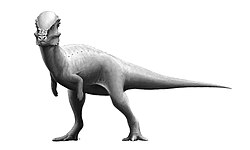Thickness and lithology

The Denver Formation consists of alluvial fan, fluvial, and paludal deposits that accumulated at the foot of the growing Rocky Mountain Front Ranges. [1] It ranges in thickness from 600 feet (180 m) to 1,580 feet (480 m) in the central part of the Denver Basin. [9] It is characterized by significant amounts of andesitic volcanic debris, [2] and is composed of primarily of light-grey to brown, lenticular bedded, loosely cemented silty claystone, mudstone, siltstone, tuffaceous sandstone and, in some areas, andesitic conglomerate. [4] [8] Beds of low-rank coal and carbonaceous shale occur in the upper 500 feet (150 m) in some areas. [10]
Several early Paleocene lava flows are present in the upper part of the Denver Formation at North and South Table Mountain near Golden, Colorado. The Ralston Dike, a body of intrusive monzonite located several miles to the northwest, probably represents the volcanic vent from which the flows erupted. [8] Generally referred to as basaltic, they are classified either as monzonite (the lowest flow) and latite (the upper two flows), [8] or as shoshonite. [11] They contain the minerals augite, plagioclase, and olivine altered to serpentine, with accessory sanidine and/or orthoclase, apatite, magnetite, and biotite. One of the flows hosts a wide variety of zeolite minerals, including analcime, thomsonite, mesolite, chabazite, and others. [11]




